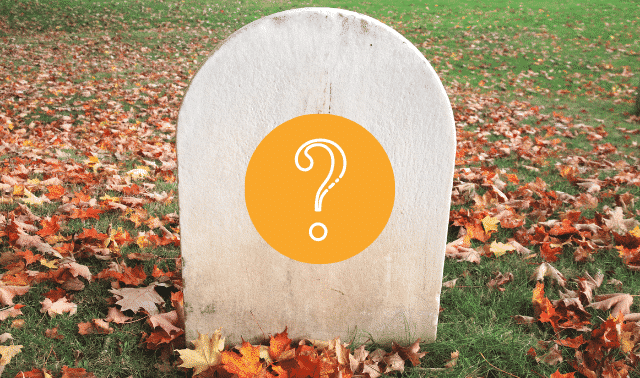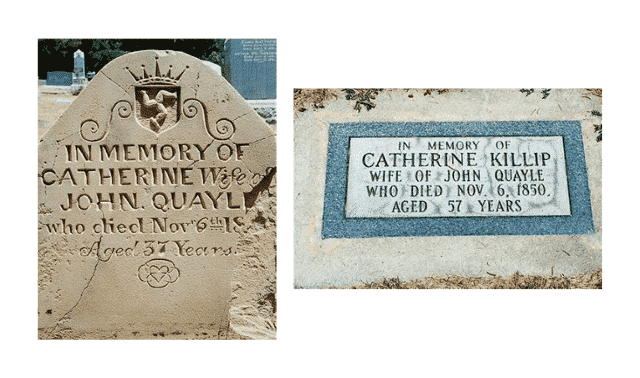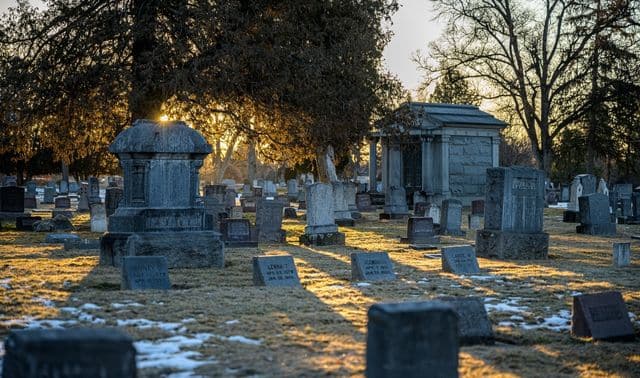Sign up for the Family Tree Newsletter Plus, you’ll receive our 10 Essential Genealogy Research Forms PDF as a special thank you!
Get Your Free Genealogy Forms
"*" indicates required fields

Below, you’ll see two headstones made for the same person, Catherine (Killip) Quayle, whose remains lie in Utah’s Salt Lake City Cemetery. Put your cemetery-sleuthing skills to the test by answering these 10 questions. Give yourself one point for each correct response.
Study These Headstones

Questions
1. The left stone is the original marker.
A. True
B. False
2. Catherine was 37 when she died.
A. True
B. False
C. Can’t tell for sure.
3. Catherine probably was 57 when she died because the person(s) who erected the new stone also knew her maiden name.
A. True
B. False
4. To resolve the age discrepancy, I’ll:
A. check cemetery and funeral home records.
B. look in the 1850 census.
C. check online sources, such as FamilySearch or Ancestry.
D. check all of the above, plus additional sources if these don’t help me resolve the discrepancy.
5. The three-legged symbol on Catherine’s headstone tells me
A. that Catherine was a marathon runner.
B. that Catherine was born with three legs.
C. where Catherine was born.
6. To learn what the three-legged symbol means, I’ll
A. check online sources for cemetery symbols.
B. consult books on cemetery symbolism such as Stories in Stone by Douglas Keister (Gibbs Smith).
C. ask friends if they can identify the mark.
D. check with local monument makers.
E. check all of the above.
7. The replacement marker consists of
A. sandstone.
B. marble.
C. granite.
8. The replacement marker likely was placed
A. after 1880.
B. before 1880.
C. shortly after Catherine died.
9. The original stone is made of
A. sandstone.
B. marble.
C. granite.
10. Catherine likely died
A. in Salt Lake City.
B. while running in a three-legged race.
C. from complications of surgery to amputate one of her legs.
Answers
1. True
2. C.
We’ll need information from other sources to know which stone is correct.
3. False.
Whoever had this new stone placed did so several decades after Catherine died. Unless we can find out who purchased the new stone (one of Catherine’s children?) and determine that the person knew Catherine’s age at death, we’ll need to confirm her age in other sources.
4. D.
5. C.
Symbols such as this one can clue you in to a person’s origin and the organizations he or she joined.
6. E.
For some of the more esoteric symbols like this one, you might have to check a variety of sources. This particular symbol is the Three Legs of Man, adopted in the 13th century to represent the armorial bearings of the Isle of Man’s native kings. The symbol still appears on the Isle of Man flag. According to the IGI and the Ancestral File databases on FamilySearch, Catherine was born in Peel, Kirk German, Isle of Man.
7. C.
You don’t have to be a geologist to learn the differences among marble, sandstone and granite. Marble is usually white with light gray or black streaks, sandstone is beige or pink, and granite is usually black or gray with flecks in the stone.
8. A.
Granite grave markers weren’t used until the 1880s.
9. A.
10. A.
We can assume Catherine died in Salt Lake City, since she’s buried there and the tombstone doesn’t indicate otherwise. To know for sure, we’d need to look at an obituary or death certificate.
Scoring
8 to 10 points
Grave Maven
5 to 7 points
Cemetery Sleuth
3 to 4 points
Boneyard Beginner
0 to 2 points
Dead Loss
A version of this article appeared in the June 2005 issue of Family Tree Magazine.
Related Reads
ADVERTISEMENT




